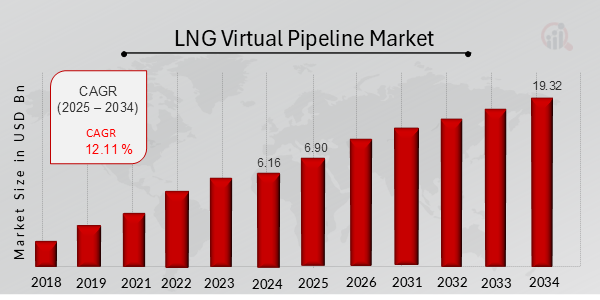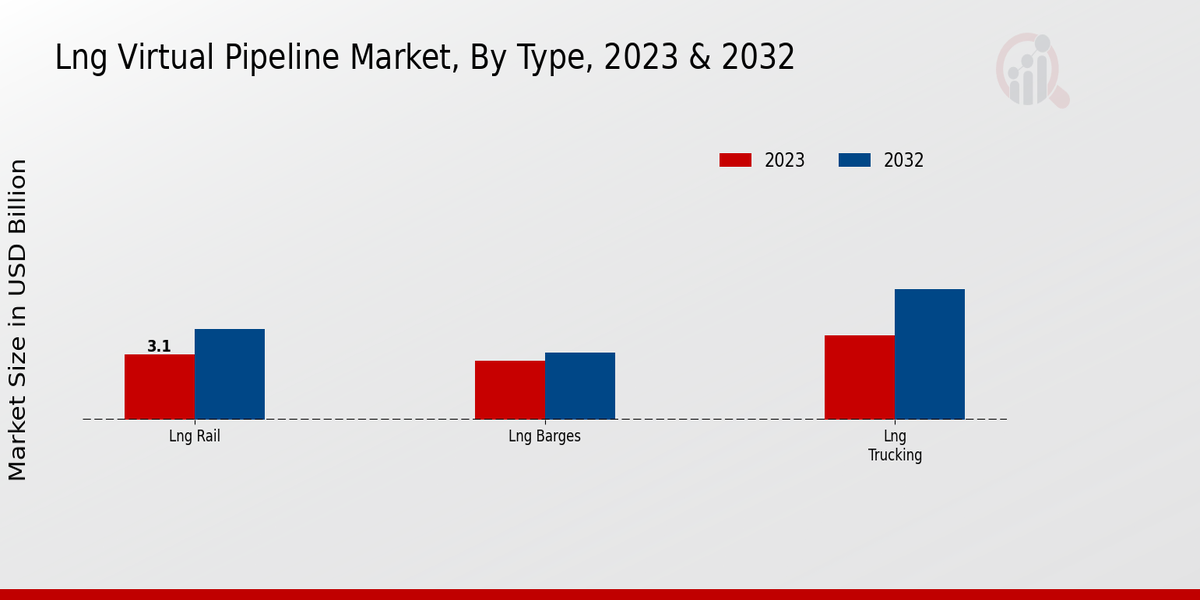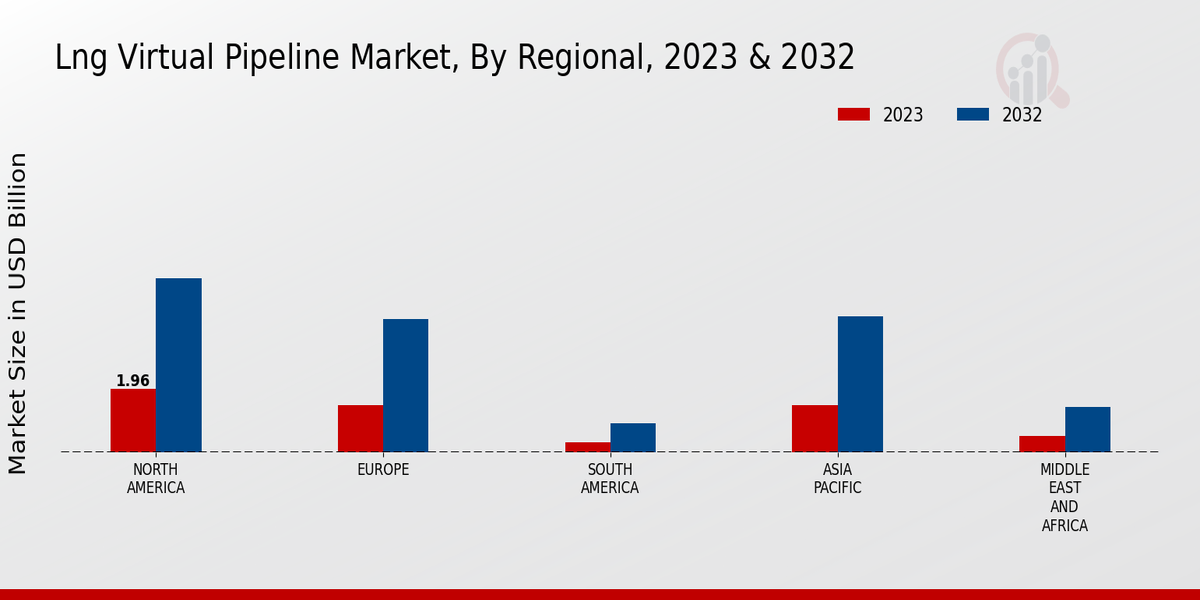Global LNG Virtual Pipeline Market Overview:
As per MRFR analysis, the LNG Virtual Pipeline Market Size was estimated at 6.16 (USD Billion) in 2024. The LNG Virtual Pipeline Market Industry is expected to grow from 6.90 (USD Billion) in 2025 to 19.32 (USD Billion) till 2034, at a CAGR (growth rate) is expected to be around 12.11% during the forecast period (2025 - 2034)
Key LNG Virtual Pipeline Market Trends Highlighted
The advancement of virtual pipeline technology is revolutionizing the LNG industry. Companies are increasingly seeking flexible and cost-effective solutions to transport LNG to remote areas. Virtual pipelines offer a safe and environmentally friendly alternative to traditional pipelines, with no physical infrastructure required. This has led to a surge in demand for virtual pipeline services, particularly in regions with limited access to existing infrastructure.
Furthermore, the growing focus on sustainability has driven the adoption of virtual pipelines. They significantly reduce carbon emissions compared to traditional transportation methods, aligning with companies' environmental commitments. Additionally, virtual pipelines provide enhanced flexibility and scalability, allowing companies to respond quickly to changing market demands and optimize their supply chains.
As the virtual pipeline market continues to expand, key market trends include the rise of small-scale LNG projects and the adoption of innovative technologies. Small-scale projects require cost-effective and scalable transportation solutions, making virtual pipelines an ideal choice. Additionally, advancements in artificial intelligence and automation are enhancing the efficiency and reliability of virtual pipeline operations, opening new opportunities for market growth.

Source: Primary Research, Secondary Research, MRFR Database and Analyst Review
LNG Virtual Pipeline Market Drivers
Rising Demand for Natural Gas
The Global LNG Virtual Pipeline Market Industry is mainly driven by the increasing demand for natural gas as a cleaner and more efficient source of fuel. Natural gas is now largely being used for power generation, industrial processes, and aiding residential heating. It has relatively lower carbon emissions compared to other fossil fuels, and this has driven its increased consumption. Consequently, there is a growing demand for virtual pipelines because they provide a more affordable and flexible way of transporting natural gas to areas that may either be remote or underserved and may lack adequate physical pipeline infrastructure.The Global LNG Virtual Pipeline Market Industry is bound to profit from such rising needs for natural gas.
Technological Advancements
Technology is one of the forces that are driving the growth of the Global LNG Virtual Pipeline Market Industry. As new technologies are developed, such as virtual metering and remote monitoring systems, it becomes easier and more efficient to operate a virtual pipeline. In addition, advances in materials and construction methods are improving the safety and reliability of virtual pipelines. These technological changes are making virtual pipelines more viable as a means of transporting natural gas, which is driving the growth of the Global LNG Virtual Pipeline Market Industry.
Government Support
Government support Another important factor driving growth in the Global LNG Virtual Pipeline Market Industry is government support. Governments all over the world are recognizing the benefits of virtual pipelines, and are providing financial and regulatory support to help with their development. In the US, for example, the government has provided funding for companies looking to develop virtual pipeline projects. The government has also helped to speed up the regulatory process for these projects, by streamlining the permitting process. This government support is helping to make virtual pipelines a more attractive option for the transport of natural gas and is helping to drive growth in the Global LNG Virtual Pipeline Market Industry.
LNG Virtual Pipeline Market Segment Insights:
LNG Virtual Pipeline Market Type Insights
The Global LNG Virtual Pipeline Market is segmented by Type into LNG Trucking, LNG Rail, and LNG Barges. LNG Trucking is expected to hold the largest market share in 2023 due to its flexibility and cost-effectiveness for short-haul transportation. The LNG Trucking segment is projected to grow at a CAGR of 11.2% during the forecast period, reaching a market valuation of USD 6.2 billion by 2032. This growth is attributed to the increasing demand for LNG as a cleaner transportation fuel and the expanding LNG infrastructure, particularly in remote areas.LNG Rail is expected to witness a significant growth rate during the forecast period due to its ability to transport large volumes of LNG over long distances. The LNG Rail segment is projected to grow at a CAGR of 12.5% during the forecast period, reaching a market valuation of USD 4.3 billion by 2032. This growth is supported by government initiatives to promote the use of LNG as a transportation fuel and the increasing investments in LNG rail infrastructure. LNG Barges are expected to play a crucial role in the transportation of LNG to remote areas and islands.The LNG Barges segment is projected to grow at a CAGR of 10.8% during the forecast period, reaching a market valuation of USD 3.2 billion by 2032. This growth is driven by the increasing demand for LNG in coastal regions and the expanding LNG barge fleet. The Global LNG Virtual Pipeline Market is expected to grow significantly in the coming years, driven by the increasing demand for LNG as a cleaner and more economical transportation fuel. The market growth is also supported by government initiatives to promote the use of LNG and the expanding LNG infrastructure.
Source: Primary Research, Secondary Research, MRFR Database and Analyst Review
LNG Virtual Pipeline Market End-User Industry Insights
The Global LNG Virtual Pipeline Market is segmented based on the end-user industry into Oil and Gas, Manufacturing, Power Generation, and Others. Among these segments, the Oil and Gas industry is expected to hold the largest market share due to the increasing need for efficient and cost-effective transportation of LNG. The Global LNG Virtual Pipeline Market revenue for the Manufacturing industry is anticipated to reach USD 2.9 billion by 2024, with a CAGR of 11.12%. Moreover, the Power Generation industry is expected to show steady growth in the LNG Virtual Pipeline Market, driven by the increasing use of LNG as a cleaner and more efficient fuel source for power plants.The Global LNG Virtual Pipeline Market revenue for the Power Generation industry is projected to reach USD 1.8 billion by 2024, exhibiting a CAGR of 9.5%.
LNG Virtual Pipeline Market Application Insights
The application segment is crucial in understanding the diverse use cases of LNG virtual pipelines. Temporary supply applications are projected to dominate the market, driven by the need for flexible and cost-effective solutions during peak demand periods or supply disruptions. Emergency response applications are also gaining traction, as LNG virtual pipelines offer rapid deployment and reliable fuel supply in disaster-stricken areas. Peak shaving applications are another key growth area, as they enable utilities to meet seasonal demand fluctuations without investing in costly infrastructure.Remote power generation applications are also witnessing significant growth, as LNG virtual pipelines provide a reliable and environmentally friendly fuel source for off-grid communities and industrial operations. The Global LNG Virtual Pipeline Market revenue is expected to reach USD 6.3 billion by 2024, showcasing the substantial growth potential of this segment.
LNG Virtual Pipeline Market Capacity Insights
The Global LNG Virtual Pipeline Market is segmented by Capacity into Small-Scale (Below 50,000 GGE), Mid-Scale (50,000 to 200,000 GGE), and Large-Scale (Over 200,000 GGE). The Small-Scale segment is expected to account for the largest share of the market in 2024. Increasing demand for LNG in remote and off-grid areas is driving the growth of this segment. The Mid-Scale segment is also expected to witness significant growth, driven by the rising demand for LNG in power generation and industrial applications. The Large-Scale segment is expected to have the smallest share of the market due to the high cost of infrastructure
LNG Virtual Pipeline Market Mode of Operation Insights
The Global LNG Virtual Pipeline Market segmentation by mode of operation comprises On-demand, Scheduled, and As-needed. Among these segments, the On-demand segment held the largest market share in 2023 and is expected to continue its dominance throughout the forecast period. The extensive use of on-demand services for immediate and flexible LNG transportation is driving the segment's growth. The Global LNG Virtual Pipeline Market revenue from the On-demand segment is projected to surpass USD 6.2 billion by 2032. The Scheduled segment, which involves pre-planned LNG deliveries, is also expected to experience significant growth due to the increasing demand for long-term contracts.The As-needed segment, which caters to occasional and sporadic LNG transportation needs, is anticipated to contribute a notable share to the overall market growth.
LNG Virtual Pipeline Market Regional Insights
The Global LNG Virtual Pipeline Market is segmented into North America, Europe, APAC, South America, and MEA. Among these regions, North America is expected to hold the largest market share in the coming years due to the increasing demand for LNG as a cleaner and cheaper fuel source. The region is also home to some of the largest LNG import terminals in the world, which will continue to drive growth in the market. Europe is another major region for the LNG virtual pipeline market, with a number of countries in the region looking to reduce their dependence on Russian gas.The APAC region is also expected to see significant growth in the market as countries in the region look to LNG to meet their growing energy needs. South America and MEA are expected to see more modest growth in the market, but there is still significant potential for growth in these regions. The Global LNG Virtual Pipeline Market is expected to grow significantly in the coming years, with a number of factors driving this growth. These include the increasing demand for LNG as a cleaner and cheaper fuel source, the growing number of LNG import terminals around the world, and the increasing investment in LNG infrastructure.
Source: Primary Research, Secondary Research, MRFR Database and Analyst Review
LNG Virtual Pipeline Market Key Players And Competitive Insights:
Major players in the LNG Virtual Pipeline Market industry are constantly engaged in research and development activities in order to expand their product portfolio and cater to the evolving demands of the market. Leading LNG Virtual Pipeline Market players are focusing on strategic collaborations with other companies to strengthen their presence in the market and gain access to new technologies and resources. The LNG Virtual Pipeline Market development is driven by factors such as rising demand for clean energy, increasing need for cost-effective transportation of LNG, and growing environmental concerns.In the LNG Virtual Pipeline Market Competitive Landscape, Shell is a leading company that offers a range of LNG virtual pipeline solutions to meet the needs of customers. The company has a strong global presence and a wide network of partners, which enables it to provide reliable and efficient LNG transportation services. Shell's virtual pipelines are designed to optimize the delivery of LNG to remote areas and to reduce the environmental impact of transportation. The company is also actively involved in research and development to improve the efficiency and reliability of its virtual pipelines.Another key player in the LNG Virtual Pipeline Market is BP. The company offers a range of LNG virtual pipeline solutions, including long-term contracts, spot contracts, and flexible contracts. BP has a strong track record in the LNG industry and a deep understanding of the market. The company's virtual pipelines are designed to meet the needs of customers who require reliable and flexible LNG transportation solutions. BP is also committed to reducing the environmental impact of its operations and is actively involved in research and development to improve the efficiency and sustainability of its virtual pipelines.
Key Companies in the LNG Virtual Pipeline Market Include:
- PTT Global LNG
- Tellurian
- Woodside Energy
- Cheniere Energy
- BP
- Shell
- Chevron
- Eni
- Sempra Energy
- NextDecade
- Petronas
- Equinor
- ExxonMobil
- TotalEnergies
- INPEX
LNG Virtual Pipeline Market Industry Developments
The global LNG virtual pipeline market is projected to reach USD 19.32 billion by 2034, exhibiting a CAGR of 12.11% during the forecast period (2025-2034). The increasing demand for natural gas as a cleaner and more efficient fuel, coupled with the growing need for reliable and flexible gas transportation solutions, is driving the market growth. Technological advancements, such as the development of smaller and more efficient liquefaction and regasification units, are further contributing to the market expansion. Key market players are actively investing in the development of LNG virtual pipeline projects to meet the rising demand for natural gas in remote and underserved areas. Partnerships and collaborations between industry participants are also expected to drive market growth in the coming years.
LNG Virtual Pipeline Market Segmentation Insights
LNG Virtual Pipeline Market Type Outlook
- LNG Trucking
- LNG Rail
- LNG Barges
LNG Virtual Pipeline Market End-User Industry Outlook
- Oil and Gas
- Manufacturing
- Power Generation
LNG Virtual Pipeline Market Application Outlook
- Temporary Supply
- Emergency Response
- Peak Shaving
- Remote Power Generation
LNG Virtual Pipeline Market Capacity Outlook
- Small-Scale (Below 50,000 GGE)
- Mid-Scale (50,000 to 200,000 GGE)
- Large-Scale (Over 200,000 GGE)
LNG Virtual Pipeline Market Mode of Operation Outlook
- On-demand
- Scheduled
- As-needed
LNG Virtual Pipeline Market Regional Outlook
- North America
- Europe
- South America
- Asia Pacifi
- Middle East and Africa
| Report Attribute/Metric |
Details |
|
Market Size 2024
|
6.16 (USD Billion)
|
|
Market Size 2025
|
6.90 (USD Billion)
|
|
Market Size 2034
|
19.32 (USD Billion)
|
|
Compound Annual Growth Rate (CAGR)
|
12.11% (2025 - 2034)
|
|
Report Coverage
|
Revenue Forecast, Competitive Landscape, Growth Factors, and Trends
|
|
Base Year
|
2024
|
|
Market Forecast Period
|
2025 - 2034
|
|
Historical Data
|
2019 - 2023
|
| Market Forecast Units |
USD Billion |
| Key Companies Profiled |
PTT Global LNG, Tellurian, Woodside Energy, Cheniere Energy, BP, Shell, Chevron, Eni, Sempra Energy, NextDecade, Petronas, Equinor, ExxonMobil, TotalEnergies, INPEX |
| Segments Covered |
Type, End-User Industry, Application, Capacity, Mode of Operation, Regional |
| Key Market Opportunities |
Growing demand for LNG as a cleaner fuel source Rising need for cost-effective and flexible LNG transportation. Development of new technologies for virtual pipeline systems Increasing investment in LNG infrastructure Expanding the use of LNG in remote and underserved areas |
| Key Market Dynamics |
LNG price volatility technological advancements infrastructure expansion government incentives rising energy demand |
| Countries Covered |
North America, Europe, APAC, South America, MEA |
Frequently Asked Questions (FAQ) :
The Global LNG Virtual Pipeline Market is expected to reach a valuation of 6.16 billion USD in 2024.
The Global LNG Virtual Pipeline Market is projected to grow at a CAGR of 12.11% from 2025 to 2034.
The Global LNG Virtual Pipeline Market is expected to reach a valuation of 19.32 billion USD in 2034.
North American region is expected to hold the largest market share in the Global LNG Virtual Pipeline Market.
Key applications of LNG Virtual Pipelines include power generation, industrial heating, and transportation.
Key competitors in the Global LNG Virtual Pipeline Market include Shell, BP, ExxonMobil, and TotalEnergies.
Major factors driving the growth of the Global LNG Virtual Pipeline Market include rising demand for natural gas, increasing environmental concerns, and technological advancements.
Challenges facing the Global LNG Virtual Pipeline Market include high upfront investment costs and regulatory hurdles.
The Russia-Ukraine conflict is expected to have a positive impact on the Global LNG Virtual Pipeline Market, as it has led to increased demand for LNG.
Key trends in the Global LNG Virtual Pipeline Market include the development of floating LNG terminals and the use of artificial intelligence to optimize operations.

















